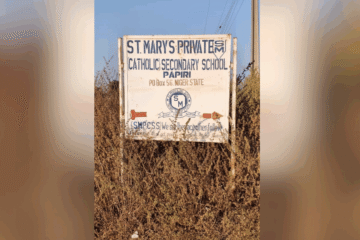
NAFDAC DG, Adeyeye
The Director General of the National Agency for Food and Drugs Agency Commission, Prof Mojisola Adeyeye, was recently in the eye of the storm; when reports quoted her to have said 50 per cent of pharmaceutical products imported into the country were fake.
In this interview with Channels Sunrise Daily team on Wednesday, Prof. Adeyeye, among other issues, explained that she was reported out of context.
According to her; she had meant that 50 per cent of the certification was fake, and not the actual medicines as was widely reported.
Excerpt:
What was it about reports where you were quoted as saying 50 per cent of the products imported into Nigeria were fake?
What I said was that the products that could have come into Nigeria were stopped due to fake certification and documentation. We stopped those products from coming in through the pre-shipment testing before they left the countries where they were coming from.
Probably it could have been misunderstood. What we have in NAFDAC now is the pre-shipment testing. Let’s say we approve 100 products to be imported. Those products must go through our clean report inspection analyst, TRIA. And those that failed would not come. This was what I meant.
What we sometimes found out was that those products in question were those that were already approved but were later discovered to have fake documentation. How we got to know was that at that point when the products were being tested; we found out that they failed the test, and we did not allow them to come to the country. None of those products came into Nigeria. There were about 140 approved products. And when you talk of approval, you are talking of a 5-year approval. So it will be tens and tens of containers over the years.
So we stopped those products through the pres-shipment test. We also dug deep into the documentation that accompanied those fake products. And we found out that over 50 per cent of the documentation was fake- that was for those that we did not allow to come in. Although we had approved after we saw them; they failed the test. So they could not be shipped into the country.
How did you discover that the documentation was fake?
Well, we have networks. You know the certificate of pharmaceutical products is supposed to be given by the central regulatory agency in India. But that was not usually the case. The state of the provinces in India also has its agency, unlike Nigeria which has only NAFDAC. The state was the one that issued this Certificate of Pharmaceutical Product (COPP). So one of our colleagues dug deep into the certificate of pharmaceutical products that we sent because they wanted to know more about our pre-shipment processes. They were the ones who discovered that over 50 per cent of the documentation was fake. So it was not the products that came into Nigeria. No. we don’t have over 50 per cent of our drugs in Nigeria as fake. No. But we still have about 12 per cent fake products which we are trying to reduce to 5 per cent.
How was it that you had approved those products, only to then discover that the certification was fake?
Yes, to authenticate the COPP, we demand that they go to our embassy in the country of shipment to certify it. And very likely, there would be doctoring of the certification. What we are trying to do now is to digitise the authentification processes. This will allow us to be here, and speak with them in their country- they will be showing us the document of certification for approval. All of the processes will be video-tapped. Why we brought up this process because we found that some of them would not go to our embassies in their countries. They would prefer to fake the certificates. So, once we get the COPP certificate; we take it through our legal team to authenticate them. Now we are digitising the certification processes.
How long does it take for approval?
It takes about 12 months to get a product approved because it goes through the dossier package which includes quality, safety and efficacy tests. They package it into chapters through our electronic platforms. It may take months before it is approved. Then they will now go for the Good Manufacturing Practice (GMP) inspection review. We also need to know the reputation of the company producing the products.
Does the application include the medicine?
Not at the beginning. But at the manufacturing stage- the GMP stage that would require our team to go there for inspection and take samples. Once we test those samples in the labouratory then; the three arms of the certification have been completed- which are the dossier review, good manufacturing practice, inspection and labouratory testing.
At what point do you determine that the documentation is fake?
First of all; it is at the initial stage that we assess the documentation. Then it goes to the good manufacturing module, and then the labouratory. By then we would have approved through our legal department that the documents are good.
Talk to us about fake products in the country. Why doesn’t your team arrest the barons?
Unfortunately, we do not catch the barons but the foot soldiers. It is just once in a while that we arrest the big guys, and whenever we do; we prosecute them. NAFDAC has a team of investigation and enforcement team. Also, the Federal task force is domiciled in NAFDAC. But in terms of food and drugs; we have a lot of challenges in that area- first because of our population, and because of the countries around our borders. But what we do is what you call market control, a module for which we benchmark the products. We also have a market control system. After registration; we go to the pre-shipment stage. And if they pass, we go and inspect the distribution house, and then they pass and go into the market. Then we do post marketing which includes the mystery shopping- just to be sure that they had not changed the products that we had approved. There was a time when we had approved a product, but just before they were delivered; we got an intelligence report that it had been cloned in China already. There are many methods we have to check the authenticity of products.
Does it mean that some of the documents had been approved here initially?
Yes. They had been approved. We have a lot of documents but it was only the COPP that we had issues with.
If some of the documents found to be fake had been approved; chances are that some of the approved products may have found their way into the country too
The chances are minimal. That is why we have what we call the portal to trace the products. We also have intelligence reports. The companies are also on alert to look out for their products from being cloned.
Are you satisfied with the Agency’s capacity for lab tests to check all the products coming into the country?
We have thousands of products that we regulate but we cannot test all of them. That was what the World Health Organization first saw when they came into our labs and saw thousands of products. They told us it was impossible to test them all. They advised us to use the risk-based testing. For example, if you are an importer, and we had tested for many years your processes, and found them to be authentic; we put you as a low-risk. Meaning; that we will not test your products all the time because we have been able to verify your integrity. So we also rely on the integrity of the importer.
How can Nigerians help?
It is a community effort. First of all; we have to engage our population daily. About 50 per cent of Nigerians are illiterate. They do not read. That is why we now use social media too. We also use the scratch mobile phone method. But soon, we plan on using the barcode method, where you would be required to use your phone to scan the barcode. We also do the onsite testing/scan. So we use your phone to scan, and it would tell you how safe the product is for consumption.
Another one is local manufacturing. Nigerians can tip us and we would visit the local manufacturer and test the products. And if we found out that the products are not good; we shut the structure down.











